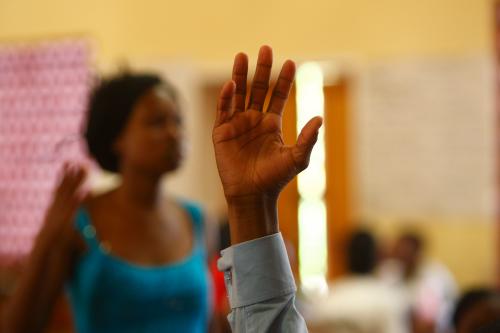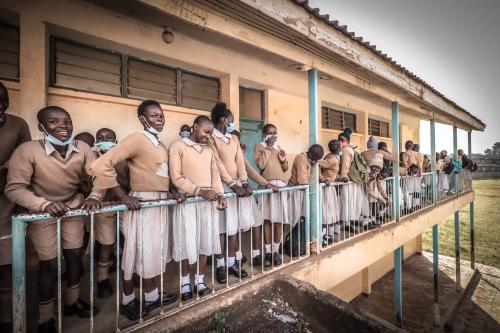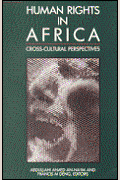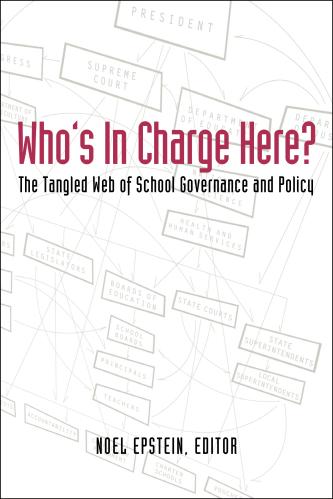South Africa has made great strides in relation to girls’ access to education, with girls and boys enrolling in equal numbers in grades one through nine. However, unequal gender norms in and around schools continue to pose barriers to the sustained participation of girls at the secondary school level and beyond.
Just before I left South Africa at the end of July, a storm had broken out around a group of young students, mostly from poor backgrounds, who had been awarded scholarships by the KwaZulu-Natal provincial government to study pharmacology in India. While many commended the government for providing these opportunities, fierce debate erupted over media reports that the Member of the Executive Council (MEC) for Health had announced that the girls and women in the group would be compelled to take a contraceptive before departing to India. Nothing was said about the boys and men in the group. This medical intervention, according to the MEC, was to avoid a repeat of what happened to four girls who had been studying in Cuba and were forced to return to South Africa after falling pregnant.
The MEC’s approach to dealing with the students’ sexuality reflects a larger problem in South Africa. Unplanned pregnancies are largely addressed within a framework that places girls and women at fault. Youth sexuality, particularly female sexuality, is viewed as a source of moral panic. Consequently, girls and unmarried women who “fall pregnant” are stigmatized, whereas the boys or men responsible for pregnancies are let off the hook. Significantly, this gender-biased perspective informs many of the archaic interventions aimed at addressing unwanted pregnancies among girls and young women.
However, while concerns about the high rates of unplanned pregnancies among secondary and university students and their potential influence on learning may be justified, such a view and the responses linked to it mask a significant underlying problem: Schools do a poor job of educating adolescents about sexual and reproductive health issues.
Such inadequate and ineffective teaching of sexual and reproductive health (SRH) issues leaves young people and girls in particular vulnerable to negative health outcomes, including sexually transmitted infections and unwanted pregnancies. For example, the 2012 South African National HIV Prevalence, Incidence and Behaviour Survey has found worrying HIV prevalence rates among girls and young women. Among the 15 to 19 year old females straddling both schooling and university education, the HIV prevalence was estimated to be 8 times that of their male counterparts. In relation to pregnancies, a recent review by Samantha Willan found that, even though South Africa has experienced a decline in teenage fertility in recent years, rates of pregnancy are still high at 30 percent among 15 to 19 year olds.
These negative health outcomes then lead to poor school attendance, low academic performance, high repetition rates, and high rates of dropout. For example, research by Martin Gustaffson concluded that even though South Africa has achieved universal primary education, of those who enroll in grade one, only 50 percent reach grade twelve, and only 39 percent complete secondary schooling. Forty two percent of the girls in the study cited pregnancy as a reason for dropping out.. Similarly, the General Household Survey 2012 found that while South Africa has achieved universal education at the primary school level—with only 1.2 percent of 7 to 15 year olds not in school—there are still challenges at the secondary school level. Fourteen percent of 16 to 18 year-olds (or 15.4 percent of 16 to 18 year-old girls, and 12.8 percent of 16 to 18 year old boys) had dropped out of school.
At the heart of the matter is that without the requisite SRH knowledge, including knowledge of their rights and the resources available to them, girls’ agency is compromised and they are not adequately prepared for life transitions that often place them in environments—like universities—that are characterized by unequal gender norms and gender-based violence, including sexual violence. Yet, universities in South Africa do very little to address the gap in students’ SRH knowledge, focusing instead on remediating their academic subject knowledge on the assumption that their high rates of drop out are due to academic under-preparation. Further, external programs targeting adolescents and young women are either severely under-resourced or informed by a moralistic framework that stigmatizes girls. Thus, if we fail to address the root of the problem at the school level, the effects of poor SRH education may undermine any attempts at empowering girls and improving their educational outcomes.
The high dropout rates in South Africa’s secondary schools, and the fact that for girls this is often linked to pregnancy and HIV infection, underscore the significance of focusing on girls in secondary schools. Specifically, what could secondary schools do differently to adequately prepare girls for transitions into higher education environments and to improve their educational outcomes? Could an approach to SRH education in secondary schools that focuses on developing awareness of the socio-political environment give girls the skills and resources they need to make informed decisions about their bodies, including whether, how and when to have sex and/or children?
The evidence cited above suggests that negative health outcomes, particularly unplanned pregnancies, make it difficult for girls to persevere and complete secondary school. What is lacking is research into whether SRH education, and in particular, one that takes into consideration the socio-cultural norms which subordinate girls and renders them unable to access and use such knowledge to make decisions about their SRH , would improve their persistence and completion of secondary education.
In the next few months I will be researching these questions, by analyzing SRH curriculum policies and teacher training, conducting retrospective interviews with young women on their school experiences of SRH, and examining the pedagogical characteristics of SRH projects that have worked both in South Africa and internationally.









Commentary
Sexual and Reproductive Health as a Barrier to Girls’ Educational Success in South Africa
September 17, 2014